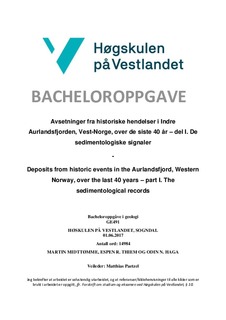| dc.description.abstract | The purpose of this investigation was to see what sedimentologic signals one could trace in sediment cores in Inner Aurlandsfjorden, Western Norway, and if it would be possible to date these signals and then trace them to their sources. In 2005, Nærøyfjorden was put on UNESCO’s world heritage site list, and parts of Aurlandsfjorden was included in this. There has been a lot of focus on preserving the unique Norwegian fjord landscape that can be seen above the water, however it is also what lays beneath the surface that is to be preserved, and this investigation intend to shed some light on what happens there.
Sampling was done in September 2017 in the inner part of Aurlandsfjorden. Nine gravity cores were taken, three in each designated area of interest. For the sedimentologic signals this part focus on, two sediment cores from each designated area were investigated. The areas of interest were Kistadypet, Stampa and the Cruise ship harbour. Signals in the sediment cores were connected to historic events that are well known in Flåm, and that could have affected the sediments. To find these signals, this investigation looked at several key factors able to tell something about source of origin for the sediments. Analysis of composition of diatoms, forams, grain sizes, organic matter and mineral matter have been done, as well as measurements of redox values, density, porosity and amounts of organic matter.
The results show clear signals from the century flood in 2014, in the upper part of the sediments in Kistadypet. The cruise ship harbour has become a more isolated system since the construction on the river delta in 1985, however traces from the century flood can also be observed. Stampa bay shows partially weak signals from Flåmselvi, while deposits connected to the filling of tunnel masses are more dominant in that area.
It is concluded that traces from historic events can be observed in the sediments in Inner Aurlandsfjorden. Different areas within the fjord are affected differently depending on location and sources of deposits. It is possible to date and trace the signals when they show clear changes in the different parameters investigated.
Only the Cruise ship harbour showed signals from the construction on the river delta in 1985 and further research could be to investigate longer sediment cores in Kistadypet and Stampa, to observe possible changes experienced in these areas. | nb_NO |
